Unit 5 reading[上学期]
文档属性
| 名称 | Unit 5 reading[上学期] |  | |
| 格式 | rar | ||
| 文件大小 | 1.1MB | ||
| 资源类型 | 教案 | ||
| 版本资源 | 人教版(新课程标准) | ||
| 科目 | 英语 | ||
| 更新时间 | 2006-07-16 22:38:00 | ||
图片预览


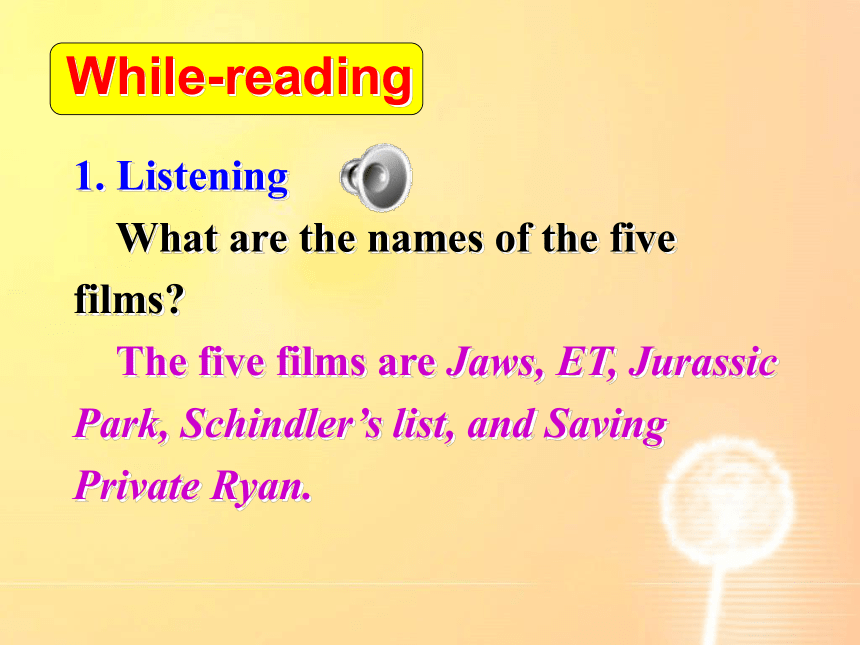
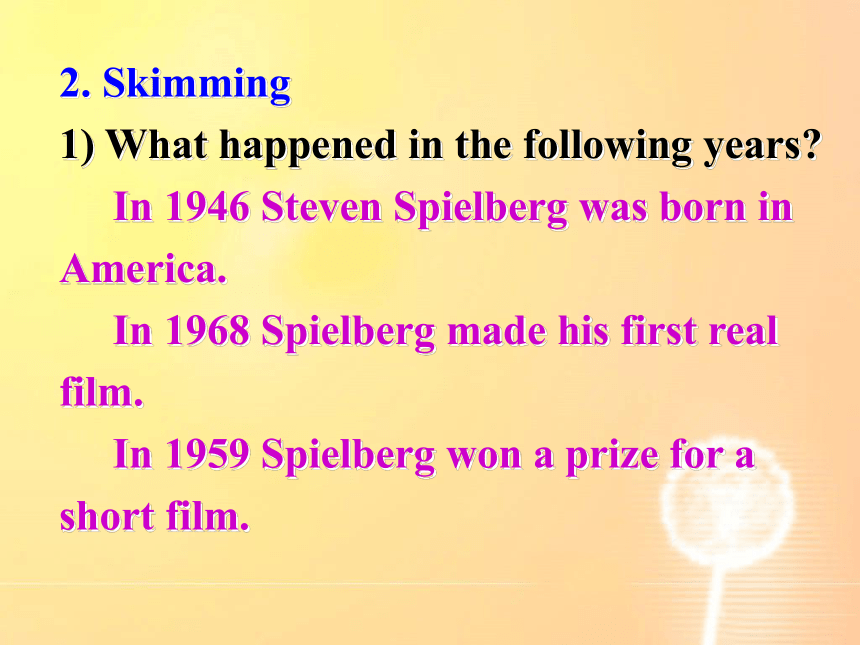
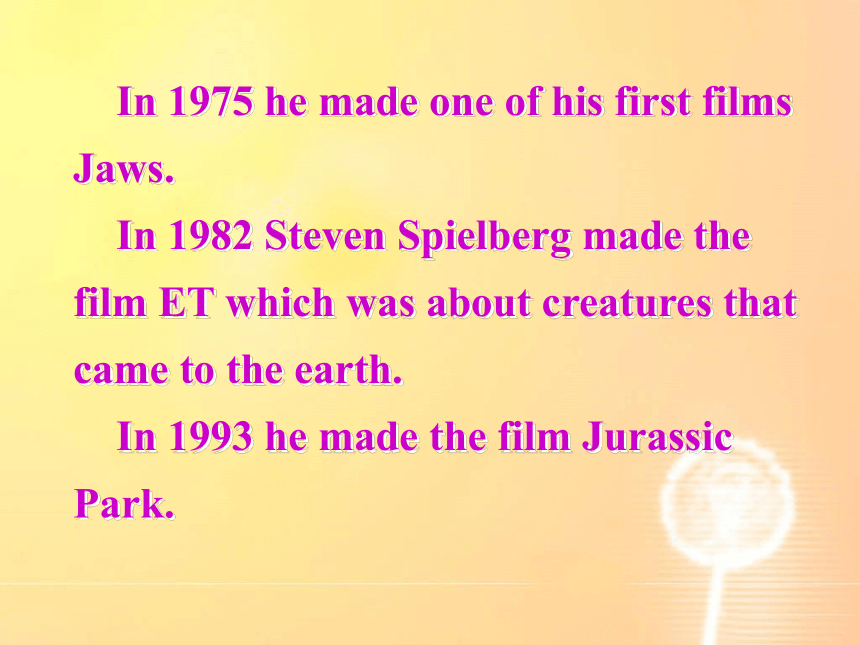
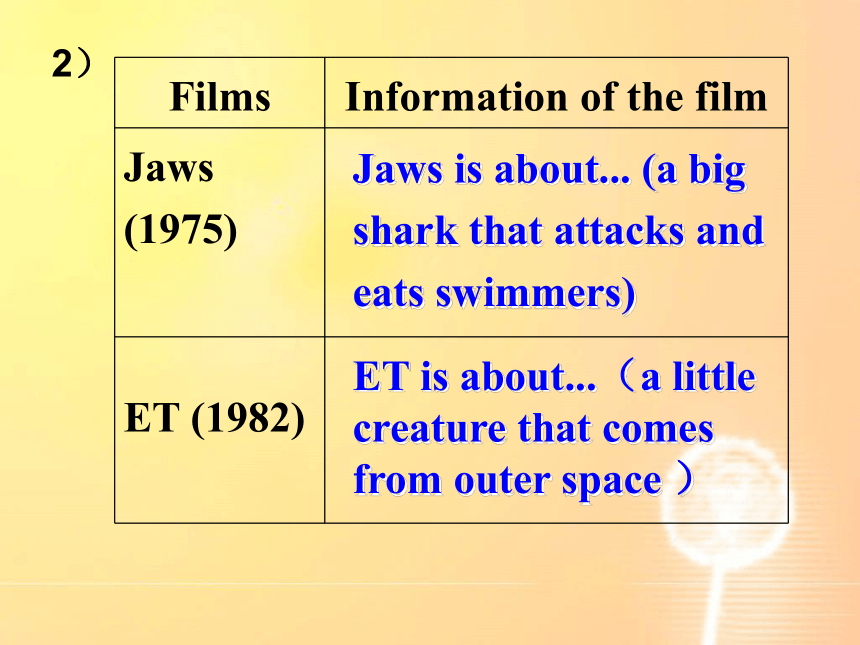
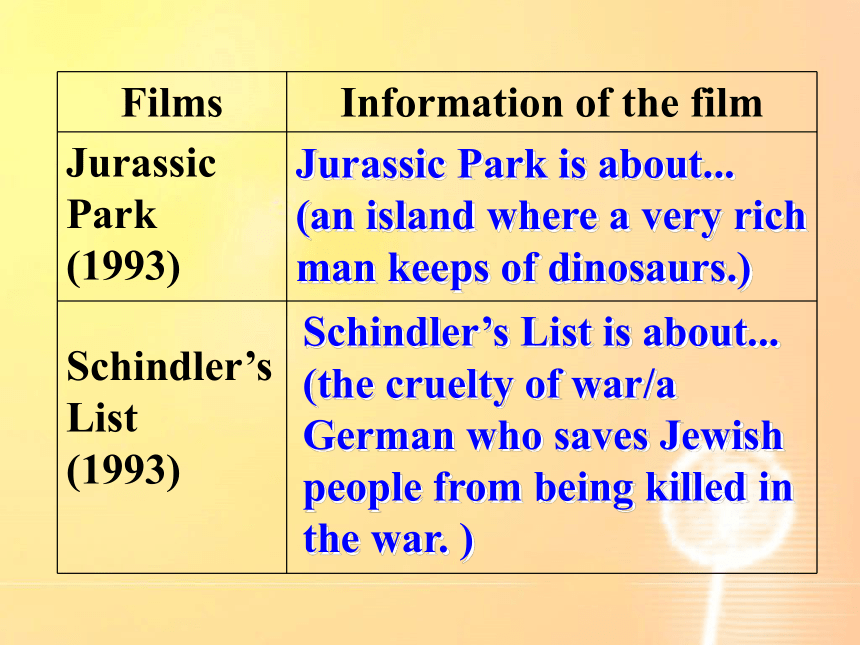
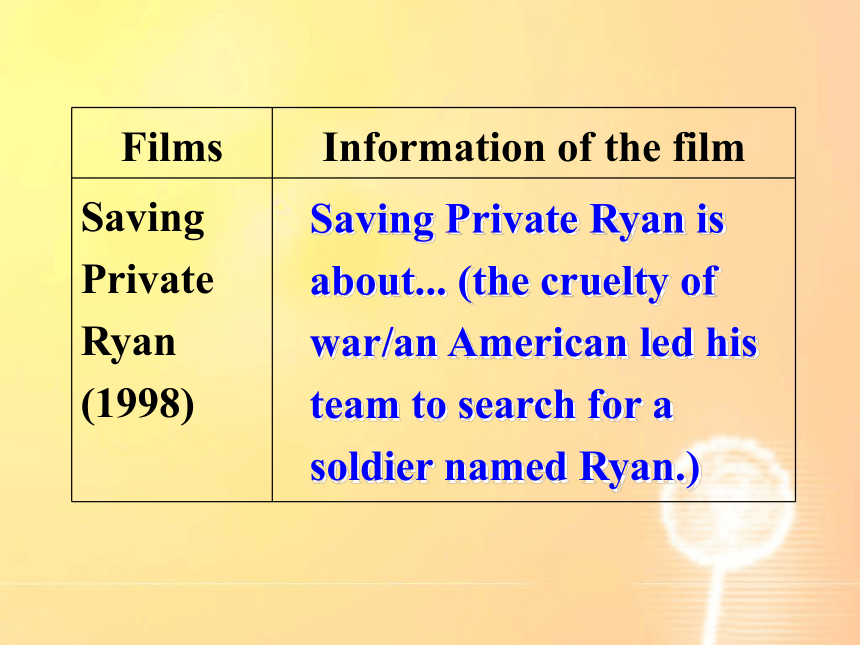
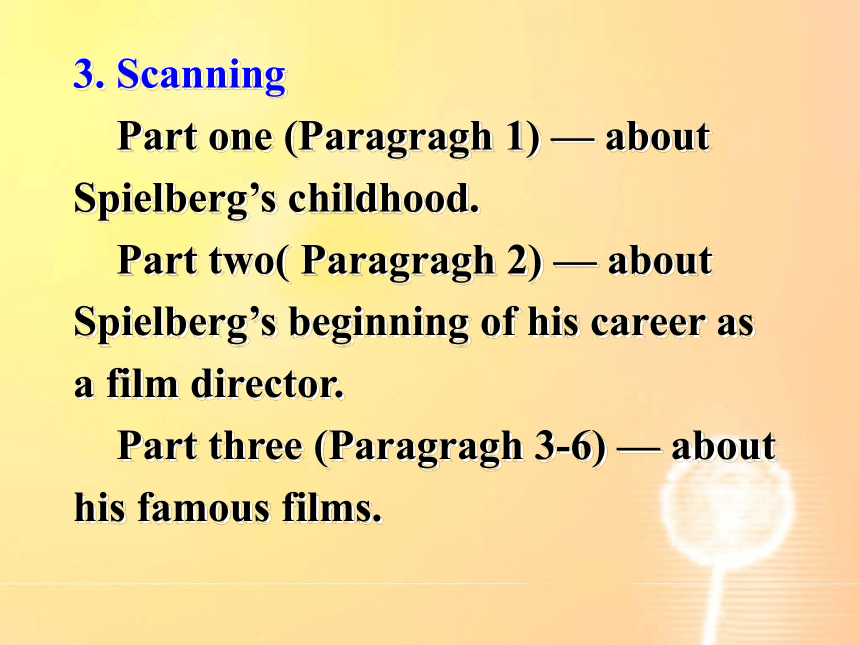
文档简介
课件24张PPT。Reading 人教修订版
高中一年级(上)
Unit 5Pre-reading1) What would the scene be like and
what happens in it?
2) Who are the main actors in that
scene and what do they do?While-reading1. Listening
What are the names of the five
films?
The five films are Jaws, ET, Jurassic
Park, Schindler’s list, and Saving
Private Ryan.2. Skimming
1) What happened in the following years?
In 1946 Steven Spielberg was born in
America.
In 1968 Spielberg made his first real
film.
In 1959 Spielberg won a prize for a
short film. In 1975 he made one of his first films
Jaws.
In 1982 Steven Spielberg made the
film ET which was about creatures that
came to the earth.
In 1993 he made the film Jurassic
Park.Jaws is about... (a big
shark that attacks and
eats swimmers)ET is about...(a little
creature that comes
from outer space )2) Jurassic Park is about...
(an island where a very rich
man keeps of dinosaurs.)Schindler’s List is about...
(the cruelty of war/a
German who saves Jewish
people from being killed in
the war. )Saving Private Ryan is
about... (the cruelty of
war/an American led his
team to search for a
soldier named Ryan.)3. Scanning
Part one (Paragragh 1) — about
Spielberg’s childhood.
Part two( Paragragh 2) — about
Spielberg’s beginning of his career as
a film director.
Part three (Paragragh 3-6) — about
his famous films. Part four (Paragragh 7) — about his secret of success—his family.
4. Retell
Steven Spielberg is one of the most famous directors in the world. He was born in America in 1946. He showed great interest in films when he was a boy. He made his first own film when he was 12. After studying English, he worked as a film director and then his career took off. He loves his family and owes his success to his wife and children. Some of his films such as Jaws and Jurassic Park are full of horror. His later films such as Schindler’s List and Saving Private Ryan are about the cruelty of war and love in life.Appreciate5. Explanation
1. Many people who saw the film were
afraid to swim in the sea…
afraid 的用法如下:
1)be afraid of sb/sth
2)be afraid to do sth/of doing sth
3)be afraid of doing sth / be afraid
+that clause 4)I’m afraid…
e.g.
1). He seldom stands on the river bank
because he is afraid that he might fall
into the river.
2). I’m afraid I can’t agree with you. 2.This was the moment when Spielberg’s
career really took off.
这就是斯皮尔伯格的事业真正腾飞的
时刻。
This is an attributive clause, and the
word “when” refers to the phrase “the
Moment”. “Took off” here means
became successful.3. Steven Spielberg said that he owes
much of his success and happiness to his
wife and children.
史蒂芬·斯皮尔伯格把他的成功与幸福
归功于他的妻子和孩子。
Happiness here is a noun. The
meaning of “owe... to...” is: be indebted
to person, thing, etc.4. After that it still took seven years
before they finally got married.
Before….(以后) 才; 不等…就;
(不多久)就
e.g.
1) 会议还没结束,他就离开了会场
He left before the meeting ended.2) 我们没等多久,汽车就来了
We hadn’t wait long before the bus
came.Post-reading 1. Why did Spielberg study English
instead of film?
Because his grade was not good
enough to go to the Film Academy.
2. Why were people who saw the film
Jaws afraid to swim in the sea? People who saw Jaws were afraid to
swim when they remembered the scenes
in which swimmers were attacked or
eaten by the shark.
3. How important is his family to
Spielberg’s career?
Spielberg says that he owes much of
his career to his family.4. What was Spielberg’s dream?
When Steven Spielberg was young, his
dream was to go to the Film Academy.
5. What have you learnt from reading
about Spielberg?
Working hard and believing in your
dream will make your dreams come true. What can we learn from the text?
Steven Spielberg is a great man. From
this article we know that people should
have their own dreams when they are
young so that they can work hard accord-
ing to their dreams. Because interest is the
best teacher, and love makes one fit for
any work (George Herbert).
Homework1. Review the story and get more
information of the director on the
computer, try to write or digest some
information from the Internet.
2. Preview the next part—word study,
and do the exercises on page 32.
高中一年级(上)
Unit 5Pre-reading1) What would the scene be like and
what happens in it?
2) Who are the main actors in that
scene and what do they do?While-reading1. Listening
What are the names of the five
films?
The five films are Jaws, ET, Jurassic
Park, Schindler’s list, and Saving
Private Ryan.2. Skimming
1) What happened in the following years?
In 1946 Steven Spielberg was born in
America.
In 1968 Spielberg made his first real
film.
In 1959 Spielberg won a prize for a
short film. In 1975 he made one of his first films
Jaws.
In 1982 Steven Spielberg made the
film ET which was about creatures that
came to the earth.
In 1993 he made the film Jurassic
Park.Jaws is about... (a big
shark that attacks and
eats swimmers)ET is about...(a little
creature that comes
from outer space )2) Jurassic Park is about...
(an island where a very rich
man keeps of dinosaurs.)Schindler’s List is about...
(the cruelty of war/a
German who saves Jewish
people from being killed in
the war. )Saving Private Ryan is
about... (the cruelty of
war/an American led his
team to search for a
soldier named Ryan.)3. Scanning
Part one (Paragragh 1) — about
Spielberg’s childhood.
Part two( Paragragh 2) — about
Spielberg’s beginning of his career as
a film director.
Part three (Paragragh 3-6) — about
his famous films. Part four (Paragragh 7) — about his secret of success—his family.
4. Retell
Steven Spielberg is one of the most famous directors in the world. He was born in America in 1946. He showed great interest in films when he was a boy. He made his first own film when he was 12. After studying English, he worked as a film director and then his career took off. He loves his family and owes his success to his wife and children. Some of his films such as Jaws and Jurassic Park are full of horror. His later films such as Schindler’s List and Saving Private Ryan are about the cruelty of war and love in life.Appreciate5. Explanation
1. Many people who saw the film were
afraid to swim in the sea…
afraid 的用法如下:
1)be afraid of sb/sth
2)be afraid to do sth/of doing sth
3)be afraid of doing sth / be afraid
+that clause 4)I’m afraid…
e.g.
1). He seldom stands on the river bank
because he is afraid that he might fall
into the river.
2). I’m afraid I can’t agree with you. 2.This was the moment when Spielberg’s
career really took off.
这就是斯皮尔伯格的事业真正腾飞的
时刻。
This is an attributive clause, and the
word “when” refers to the phrase “the
Moment”. “Took off” here means
became successful.3. Steven Spielberg said that he owes
much of his success and happiness to his
wife and children.
史蒂芬·斯皮尔伯格把他的成功与幸福
归功于他的妻子和孩子。
Happiness here is a noun. The
meaning of “owe... to...” is: be indebted
to person, thing, etc.4. After that it still took seven years
before they finally got married.
Before….(以后) 才; 不等…就;
(不多久)就
e.g.
1) 会议还没结束,他就离开了会场
He left before the meeting ended.2) 我们没等多久,汽车就来了
We hadn’t wait long before the bus
came.Post-reading 1. Why did Spielberg study English
instead of film?
Because his grade was not good
enough to go to the Film Academy.
2. Why were people who saw the film
Jaws afraid to swim in the sea? People who saw Jaws were afraid to
swim when they remembered the scenes
in which swimmers were attacked or
eaten by the shark.
3. How important is his family to
Spielberg’s career?
Spielberg says that he owes much of
his career to his family.4. What was Spielberg’s dream?
When Steven Spielberg was young, his
dream was to go to the Film Academy.
5. What have you learnt from reading
about Spielberg?
Working hard and believing in your
dream will make your dreams come true. What can we learn from the text?
Steven Spielberg is a great man. From
this article we know that people should
have their own dreams when they are
young so that they can work hard accord-
ing to their dreams. Because interest is the
best teacher, and love makes one fit for
any work (George Herbert).
Homework1. Review the story and get more
information of the director on the
computer, try to write or digest some
information from the Internet.
2. Preview the next part—word study,
and do the exercises on page 32.
